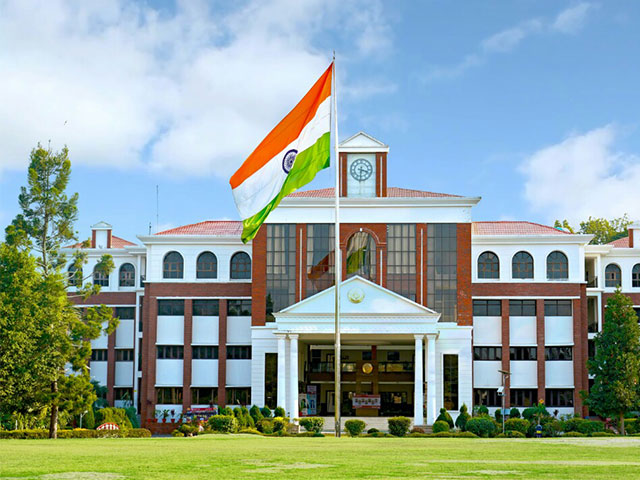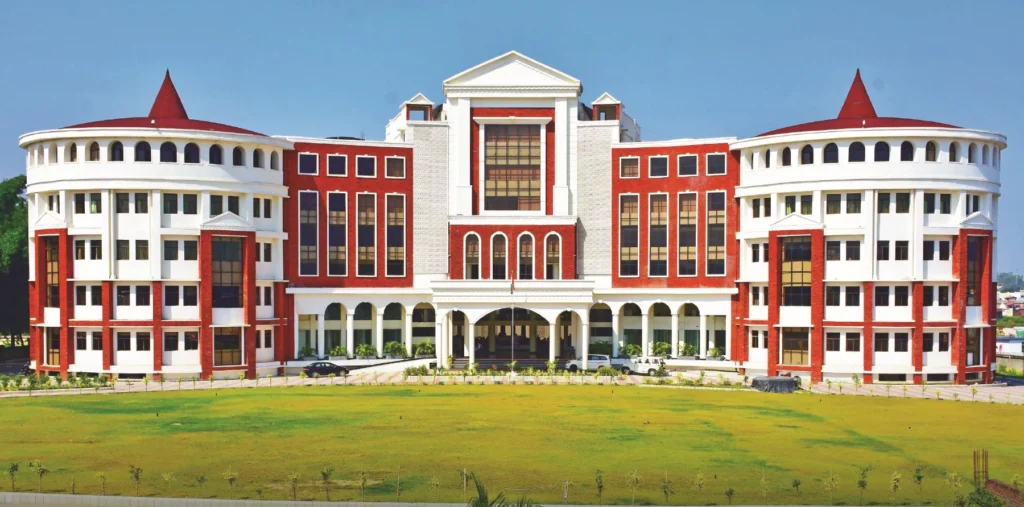
Graphic Era (Deemed to be University)
His vision gained concrete shape in 1996 the form of the Graphic Era Institute of Technology (GEIT). In 2008, it was accorded the status of Deemed University under Section 3 of the UGCAct, 1956 vide Notification F.9-48/2007-U.3 (A) dated 14 August 2008 and approved by the Ministry of Human Resource Development, Government of India.
Today, Graphic Era (Deemed to be University) stands tall as NAAC ‘A+’ accredited university with 7 NBA accredited programs and is ranked among the Top 100 Universities of India by National Institutional Ranking Framework (NIRF), Ministry of Education with All India Rank 62 in the Engineering Category, All India Rank 65 in Management Category, and All India Rank 55 in the University Category.
The premier university regards industry-academia partnership as an integral part of teaching methodology & curriculum and has taken big initiative in engineering programs by getting into partnerships with Tata Technologies and IBM. Moreover, it hosts Technology Business Incubator that funds, mentors and nurtures ideas, start-ups and technology-based entrepreneurship.
Graphic Era (Deemed to be University) has acquired transnational dimensions through student exchange and knowledge-sharing programs with many foreign universities and has been acclaimed and honored at international forums for its brilliance in upholding the highest standards of education. The alumni of Graphic Era are making their mark worldwide in marquee brands like Apple, Google, Microsoft, HSBC, to name a few and in the service of the nation in all wings of the Armed forces
Graphic Era Hill University

Graphic Era Hill University, founded in 2011 by Prof. (Dr.) Kamal Ghanshala, aims to transform youth futures through quality education. Located in Dehradun, Uttarakhand, Graphic Era Hill University is a private institution established under Section 2(f) of the UGC Act, 1956, as part of the Graphic Era Educational Society.
Graphic Era Hill University is renowned for its innovative education system, producing professionals across industries. The picturesque Dehradun campus, bordered by Rajaji National Park and Clement Town Cantonment, offers a vibrant environment with state-of-the-art facilities, including sports amenities, modern accommodations, gyms, libraries, computer centers, high-speed Wi-Fi, smart classrooms, auditoriums, multiple cafeterias, and recreational areas.
Graphic Era Hill University also has campuses in Bhimtal and Haldwani. The Bhimtal campus, set in the scenic Kumaon region, offers a tranquil learning environment with modern facilities. The Haldwani campus combines modern infrastructure with the region’s cultural heritage, providing a rich educational experience.
Graphic Era Hill University offers undergraduate, postgraduate, and doctoral programs in engineering, law, management, computer applications, humanities, applied sciences, animation, fashion designing, journalism, mass communication, and agriculture. The university attracts a diverse student population from across India and abroad, enriching the cultural experience on campus. Graphic Era Hill University is committed to accessible
education, offering a 25% domicile fee concession to Uttarakhand students and additional discounts to deserving candidates. The university emphasizes holistic development through co-curricular and extracurricular activities, including sports, cultural events, and clubs, and encourages community service and social initiatives.
About the Conference
The Conference is the second consecutive event being organized in line with India’s vision for Vikishit Bharat 2047 and commitment to achieving 500 GW of non-fossil fuel-based generation capacity in the country by 2030, and carbon neutrality by 2070. India has made a significant progress in this endeavour with current total installed capacity of 234 GW from renewable energy. Solar has achieved a significant milestone of 116 GW installed capacity. India is leading the renewable energy program with nearly 50% of total installed capacity coming from non-fossil fuel-based generation. The government intends to achieve a target of around 400GW from solar by 2030. In addition to solar energy, there is a constant effort to develop wind energy, hybrid systems, energy storage, bioenergy, geothermal and new technologies such as green hydrogen to proliferate clean energy utilization. Further, a 100GW target is set for nuclear power generation.
The Ministry of New and Renewable Energy (MNRE), Government of India has initiated various programs for expansion of development and deployment of solar power for various applications. Solar power deployment so far has been mainly done on ground and roof tops. It is imperative to explore the full spectrum of solar energy applications. Solar has tremendous potential for addressing sustainable development needs in agriculture sector, including rural development. While solar pumps are already effective in addressing irrigation needs, an innovative approach is needed for integrating all possible applications for optimum utilization of land. For example, integration of solar rooftop and agrivoltaics with cold storage offers a promising option for addressing preservation of agricultural produce and also generating income of farmers.
Technology development and manufacturing are key elements for making India a developed nation. It requires robust policy and ecosystem scaling up efforts for integrated application-oriented research for technology development and deployment for all possible applications for sustained growth of clean energy and achieving carbon neutrality by 2070. Effectively, efforts have to be expanded vigorously for multiple tasks; accelerate capacity-building efforts, strengthen research and innovation, develop a skilled workforce, support technological advancement, manufacturing, and efficient project implementation in the clean energy field.
With the above background, the proposed three-day National Conference aims to bring together experts, faculties, researchers and policy makers from the related R&D/academic organizations, industries, government departments/ministries, stakeholders including project developers, financiers and project implementers to share their experiences in research, technology development, technology deployment, policies and experiences in financing, project development and implementation, including discussion on integration of technologies for promotion of clean energy for various applications with special focus on solar energy. The deliberations would focus on collaboration for development of projects for implementation. An exhibition would also be organized facilitating industries and developers to show case their products.
Structure of the Conference
The three-day National Conference will begin with an inaugural session, followed by a series of technical sessions. Each technical session will commence with a key note address from a leading expert in the field, covering developments in policy, technology, and financial aspects. This will be followed by presentations from invited speakers on relevant topics. Each session will conclude with a round table panel discussion, exploring collaboration for research projects for technology development and demonstration.
A field visit to the University’s Department of Agriculture at Banjarawala (around 20 km from Dehradun) has been planned to showcase the recent initiative of GEU on setting up an innovative integrated rooftop and agrivoltaics integrated cold storage system and solar pumping system.
About the Centre of Energy Research
The Centre of Energy Research (CER) at Graphic Era (Deemed to be University), Dehradun is an initiative to create enabling environment encouraging faculty and researchers for carrying out research and development activities in clean energy towards achieving the Government of India’s plan of net zero emission by 2070. The various research areas included are as follows:
“Solar thermal, Concentrated Solar Power, Solar Cells, heterojunction solar cells new materials for solar cells such as perovskites, etc. , wind energy, off-shore wind energy, green hydrogen, biomass energy, electrolysis, energy storage systems, molten salts, e-mobility, new generation battery energy storage systems, carbon capture methods, clean coal technologies, improving efficiency of coal power plants, carbon capture, carbon footprints, geothermal energy utilizing hot springs, circular economy, nuclear energy, power electronics, standards, etc.”
The CER is envisioned as a multi-disciplinary centre and aims to establish infrastructure at par with international level for conducting research and various academic courses such as M. Sc, B. Tech, M. Tech and Ph. D in the field of clean energy.
Vision
- To achieve excellence in research, education, innovation for technology development and deployment in the area of clean energy for sustainable development.
- To collaborate with leading R&D/academic institutions, industries, etc. for developing collaborative projects for technology development and demonstration for promotion of clean energy for various applications.
- To contribute to scaling up research, technology development, manufacture and skilled workforce efforts to meet the technology development, manufacturing and deployment needs of the country.
Initiatives
The following activities have been taken up:
- Organized a “National Workshop on Policy Interventions for Promoting Solar Farming for Socio Economic Development and for Net Zero Emission Mission” on 30 September – 4 October 2024 at GEU. The workshop was organized in association with the National Institute of Solar Energy (NISE) of the Ministry of New and Renewable Energy (MNRE), Government of India, National Solar Energy Federation of India (NSEFI) and GIZ Germany.
- MoU between GEU and NISE for collaboration in research, training and conducting joint academic courses such as M. Tech.
- MoU between GEU and IIT Roorkee for collaboration in research, events, trainings.
Ongoing Research Programmes
- The CER, GEU has developed a RD&D Project in association with Indian Agricultural Research Institute (IARI-ICAR), Delhi on “An Innovative Integrated SPV System for Proliferation of Solar Rooftop and Agrivoltaics for Sustainable Agriculture and Rural Development and contributing to Net Zero Emission Mission”. The proposal is being submitted to MNRE for consideration of funding.
- The CER, GEU in association with Space Application Centre (SAC), ISRO and IMD is developing a program for Solar Resource Assessment for Uttarakhand. Interactions with IMD and SAC is going on for mapping satellite data and ground measurements for actual solar resource potential assessment for Uttarakhand.
Opening of the submission of full-length paper
Last date of submission of abstract
Within one week from the date of receipt
Notification of Acceptance of abstract
15 Nov 2025
25 Oct 2025
Last date of full-length camera-ready paper submission
16 Nov 2025
01 Nov 2025
Last date of registration

